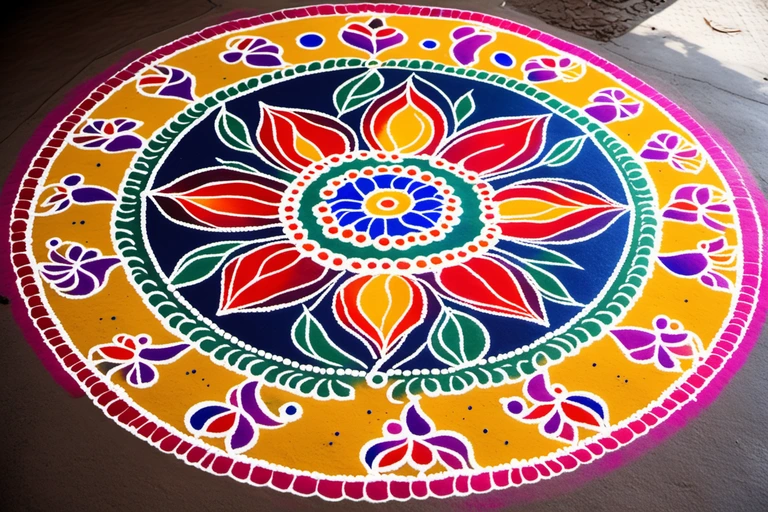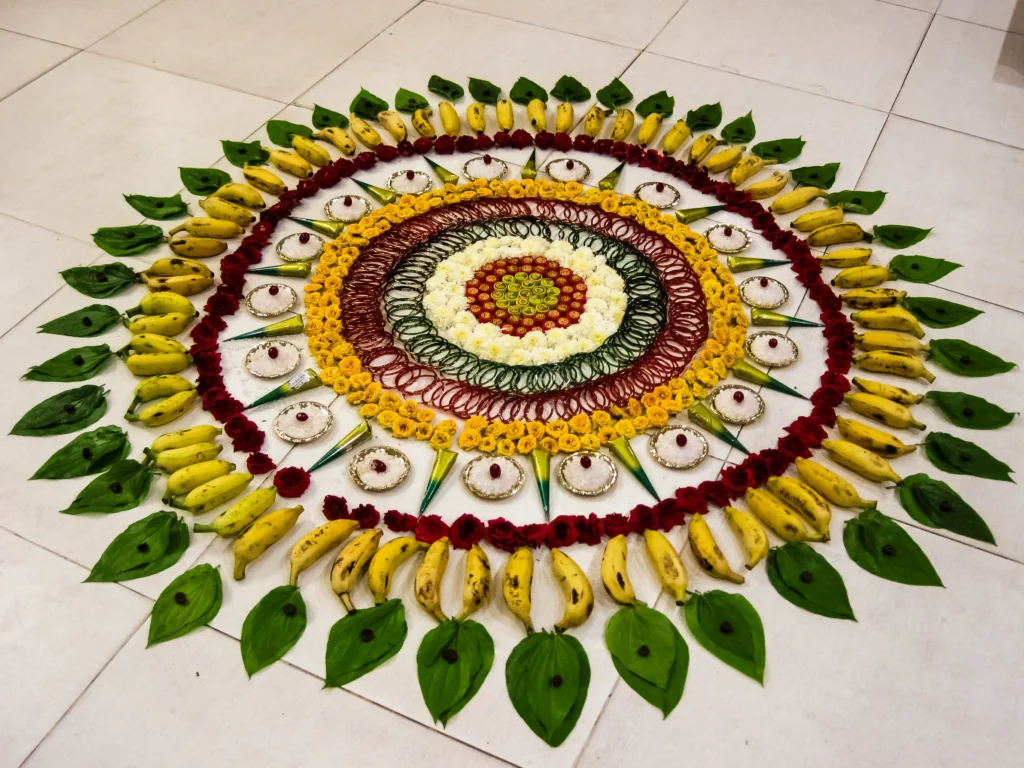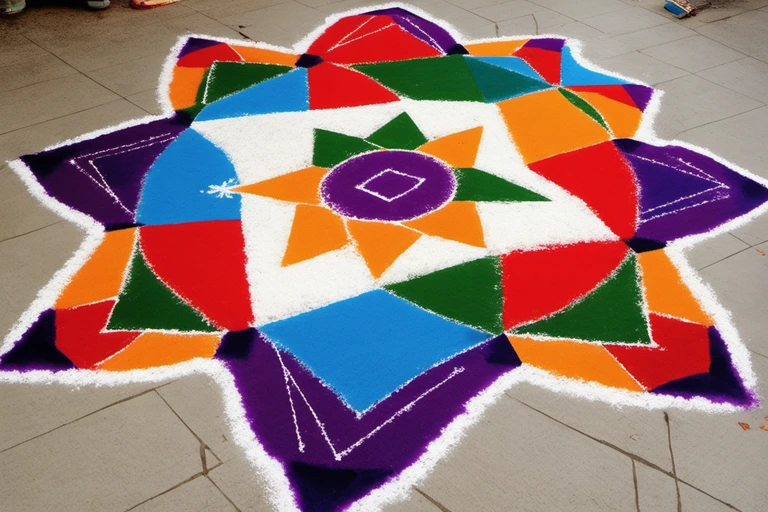Discover the captivating world of Rangoli design, a mesmerizing Indian art form filled with vibrant colours and intricate patterns.
Rangoli is a traditional Indian art form that involves creating beautiful and intricate patterns on the floor using coloured rice, sand, or flower petals. Rangoli is often made during festivals and special occasions, and it is believed to bring good luck and prosperity to the home.
There are many different types of rangoli designs, but they all share some common elements. Rangoli designs are typically symmetrical, and they often use geometric shapes such as triangles, squares, and circles. They may also include flowers, animals, or other symbols that have special meaning in Indian culture.
Rangoli Designs
Creating a rangoli is a skill that requires both precision and creativity. Traditional designs are usually geometric or inspired by nature, such as flowers, leaves, peacocks, or religious symbols. The techniques can vary depending on the region, but some common methods include:
Freehand Rangoli: The artist uses their imagination and skills to draw intricate designs directly onto the floor using a variety of tools like cones filled with coloured powder or rice flour.

Stencil Rangoli: In this method, stencils are used to create a basic outline, and then the artist fills in the colours and details.

See the stencil designs from Flipkart
Flower Petal Rangoli: Instead of coloured powders, fresh flower petals are used to create exquisite designs, often during religious ceremonies.

Floating Rangoli: This style involves creating rangoli designs on water, usually in bowls or containers, using floating materials like petals or candles.

Geometric rangoli: These rangolis are made up of geometric shapes, such as triangles, squares, and circles. They can be simple or complex, and they often have a strong symmetry.

Cultural Significance of Rangoli
Beyond its aesthetic appeal, rangoli plays a crucial role in Indian culture and society:
- Welcoming Guests: Rangoli is an essential part of Indian hospitality. It is believed to invite the deity of prosperity, Goddess Lakshmi, into the home and create a warm and auspicious ambience for guests.
- Festivals and Celebrations: Rangoli is prominently featured during major festivals like Diwali, Pongal, Navratri, and Onam. It symbolizes joy, celebration, and the triumph of good over evil.
- Religious Practices: Rangoli is considered a sacred practice and is often created during religious rituals and ceremonies.
- Promoting Creativity: Rangoli encourages creativity and artistic expression among people, especially women, who play a significant role in designing these vibrant patterns.
Preserving the Tradition
While the art of rangoli has deep cultural roots, it faces challenges in modern times. With changing lifestyles and urbanization, the traditional practice of rangoli-making is gradually diminishing. However, efforts are being made to preserve and promote this beautiful art form.
Workshops, exhibitions, and cultural events are organized to showcase rangoli artists’ talents and inspire the younger generation to embrace this traditional art. Additionally, social media platforms have become a powerful medium for artists to share their stunning creations with a global audience, encouraging cross-cultural appreciation.
Steps to create rangoli design
Rangoli is a very creative art form, and there is no right or wrong way to create a rangoli design. However, there are some basic principles that can help you create beautiful and symmetrical rangolis.
- Start with a simple design. If you are new to rangoli, it is best to start with a simple design. This will help you learn the basic principles of rangoli design and make it easier to create more complex designs in the future.
- Use a grid. A grid can help you create a symmetrical rangoli design. You can draw a grid on the floor with chalk or tape, or you can use a piece of graph paper.
- Start in the centre. When you are creating a rangoli design, start in the centre and work your way out. This will help you keep your design symmetrical.
- Use different colours. Rangoli designs are typically very colourful, so use a variety of colours to create a beautiful and vibrant design.
- Be creative. There are no rules when it comes to rangoli design, so be creative and have fun!
Rangoli is a beautiful and creative art form that is enjoyed by people of all ages in India. If you are interested in learning more about rangoli design, there are many resources available online and in libraries. With a little practice, you can create beautiful and intricate rangolis that will bring good luck and prosperity to your home.
Here are some additional tips for creating rangoli designs:
- Use a variety of materials. In addition to coloured rice, sand, and flower petals, you can also use coloured chalk, beads, sequins, or even leaves to create your rangoli design.
- Choose a design that is appropriate for the occasion. For example, you might choose a floral design for a wedding or a geometric design for Diwali.
- Make sure your design is symmetrical. This will help it look more professional and polished.
- Have fun! Rangoli is a creative art form, so let your imagination run wild.
Here are some of the materials used for rangoli that are available in the Indian market:
- Coloured rice: This is a traditional material for rangoli, and it is available in a variety of colours. Coloured rice is easy to work with, and it is also non-toxic, making it safe for children to use.
- Sand: Sand is another traditional material for rangoli, and it is available in a variety of colours. Sand is also easy to work with, and it can be used to create intricate designs.
- Flower petals: Flower petals are a beautiful and fragrant material for rangoli, and they are available in a variety of colours. Flower petals can be used to create simple or elaborate designs.
- Coloured chalk: Colored chalk is a versatile material that can be used to create rangoli designs. Coloured chalk is available in a variety of colours, and it is easy to find in most Indian markets.
- Beads: Beads are a colourful and eye-catching material that can be used to create rangoli designs. Beads are available in a variety of colours and sizes, and they can be used to create simple or elaborate designs.
- Sequins: Sequins are a sparkly and eye-catching material that can be used to create rangoli designs. Sequins are available in a variety of colours and sizes, and they can be used to create simple or elaborate designs.
- Leaves: Leaves are a natural and beautiful material that can be used to create rangoli designs. Leaves are available in a variety of colours and shapes, and they can be used to create simple or elaborate designs.
These are just a few of the materials that can be used for rangoli. With a little creativity, you can use any materials you have on hand to create beautiful and unique rangoli designs.
I hope this blog has inspired you to learn more about rangoli design and to create your own beautiful rangolis.
Follow Johnny Scribe for more such content.
